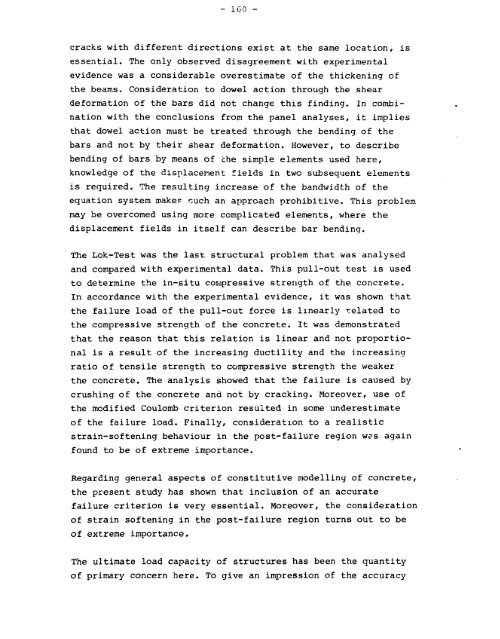Nonlinear Finite Element Analysis of Concrete Structures
Nonlinear Finite Element Analysis of Concrete Structures
Nonlinear Finite Element Analysis of Concrete Structures
Create successful ePaper yourself
Turn your PDF publications into a flip-book with our unique Google optimized e-Paper software.
- 1G0 -<br />
cracks with different directions exist at the same location, is<br />
essential. The only observed disagreement with experimental<br />
evidence was a considerable overestimate <strong>of</strong> the thickening <strong>of</strong><br />
the beams. Consideration to dowel action through the shear<br />
deformation <strong>of</strong> the bars did not change this finding. In combination<br />
with the conclusions from the panel analyses, it implies<br />
that dowel action must be treated through the bending <strong>of</strong> the<br />
bars and not by their shear deformation. However, to describe<br />
bending <strong>of</strong> bars by means <strong>of</strong> the simple elements used here,<br />
knowledge <strong>of</strong> the displacement fields in two subsequent elements<br />
is required. The resulting increase <strong>of</strong> the bandwidth <strong>of</strong> the<br />
equation system make? nuch an approach prohibitive. This problem<br />
may be overcomed using more complicated elements, where the<br />
displacement fields in itself can describe bar bending.<br />
The Lok-Test was the last structural problem that was analysed<br />
and compared with experimental data. This pull-out test is used<br />
to determine the in-situ compressive strength <strong>of</strong> the concrete.<br />
In accordance with the experimental evidence, it was shown that<br />
the failure load <strong>of</strong> the pull-out force is linearly related to<br />
the compressive strength <strong>of</strong> the concrete. It was demonstrated<br />
that the reason that this relation is linear and not proportional<br />
is a result <strong>of</strong> the increasing ductility and the increasing<br />
ratio <strong>of</strong> tensile strength to compressive strength the weaker<br />
the concrete. The analysis showed that the failure is caused by<br />
crushing <strong>of</strong> the concrete and not by cracking. Moreover, use <strong>of</strong><br />
the modified Coulomb criterion resulted in some underestimate<br />
<strong>of</strong> the failure load. Finally, consideration to a realistic<br />
strain-s<strong>of</strong>tening behaviour in the post-failure region wes again<br />
found to be <strong>of</strong> extreme importance.<br />
Regarding general aspects <strong>of</strong> constitutive modelling <strong>of</strong> concrete,<br />
the present study has shown that inclusion <strong>of</strong> an accurate<br />
failure criterion is very essential. Moreover, the consideration<br />
<strong>of</strong> strain s<strong>of</strong>tening in the post-failure region turns out to be<br />
<strong>of</strong> extreme importance.<br />
The ultimate load capacity <strong>of</strong> structures has been the quantity<br />
<strong>of</strong> primary concern here. To give an impression <strong>of</strong> the accuracy
















